Conflict Management in China: The Case of Muslim Uyghurs in Xinjiang Province
Keywords:
Xinjiang, Uyghurs, China's Ethnic Policy, Conflict ManagementAbstract
This research aims to examine the role of the Chinese government in managing conflicts in the case of Muslim Uyghurs in Xinjiang since 1949. A qualitative method has been used to reveal the causes of conflicts, China’s ethnic policies and conflict resolutions in the view of the Chinese government, ethnic people and the West. The findings indicate that ethnic minority policy is the main factor that has intensified conflict. China’s conflict management methods are forcing or competing to win over minorities, compromising in order to lessen conflict and collaborating to find a solution. China’s ethnic policies depend on the internal and external situation and leaders. In the early years of the PRC, Mao Zedong’s policy was cultural assimilation and Sinicization by eradicating religion and the Muslim Uyghur identity. During the reform period in the 1980s-1990s, cultural reconciliation and economic development were conducted to establish harmony between the ethnic minorities in China. In the 2000s -2010s, anti-government groups in Xinjiang were supported by radical and external Islamic groups and the government’s ethnic minority policy was to balance between the forces and collaboration through economic development and cultural support.
References
2. Busby, Scott. 2018. Testimony of Deputy Assistant Secretary Scott Busby Senate Foreign Relations Committee Subcommittee on East Asia, The Pacific, And International Cybersecurity Policy. Washington, D.C.: United State Senate. December 4, 2018. Accessed June 17, 2020. https://www.foreign.senate.gov/imomedia/
doc/120418 _Busby_Testimony.pdf
3. Clarke, Colin P. and Paul Rexton Kan. 2017. “Uighur Foreign Fighters: An Underexamined Jihadist Challenge.” The International Centre for Counter-Terrorism – The Hague 8(5): 1-19.
4. Dabphet, Siriporn. 2020. Research Paper: Conflict Management in China: A Case of Muslim Uyghurs in Xinjiang. Bangkok: Thailand Research Fund (TRF).
5. Dabphet, Siriporn. 2019. The Cultural Revolution in China. Bangkok: Charansanitwong Kanphim.
6. Kuşçu Bonnenfant, Işık. 2018. “Constructing the Uyghur Diaspora: Identity Politics and the Transnational Uyghur Community.” The Uyghur Community: Diaspora, Identity and Geopolitics, edited by Kurmangaliyeva Ercilasun, Güljanat, Ercilasun, Konuralp, 85-103. New York: Palgrave Macmillan.
7. Castets, Rémi. 2003. “The Uyghurs in Xinjiang – The Malaise Grows.” China Perspectives 49 September-October, 1-22.
8. Dabphet, Siriporn. 2016. “China’s Economic Development: Income Inequality and Ethnicity.” In Proceedings of the 2016 ICBTS Conference, Boston, June 28 – July 4.
9. Gladney, Dru C. 2004. Dislocating China: Reflections on Muslims, Minorities, and other Subaltern Subjects. Chicago, IL: University of Chicago Press.
10. Greitens, Sheena C., Lee, Myunghee, and Yazici, Emir. 2020. “Understanding China’s ‘preventive repression’ in Xinjiang.” Order from Chaos, March 4. Accessed April 17, 2020. https://www.brookings. edu/blog/order-from-chaos/2020/03/04/understanding-chinaspreventive-repression-in-xinjiang/
11. Hope, Joseph. 2018. “The Growing Importance of Global Islamic Extremism to China.” June 12. Accessed April 17, 2020. https://thestrategybridge.org/the-bridge/2018/6/12/the-growing-importance-of-global-islamic-extremism-to-china
12. Howell, Anthony and Fan C. Cindy. 2011. “Migration and Inequality in Xinjiang: A Survey of Han and Uyghur Migrants in Urumqi.” Eurasian Geography and Economics 52(1): 119–139.
13. Lindenstrauss, Gallia and Galia Lavi. 2016. “China and Turkey: Closer Relations Mixed with Suspicion.” Strategic Assessment 19(2): 119-127. Accessed April 17, 2020. https://www.researchgate. net/publication/317646376_China_and_Turkey_Closer_RelationsMixed_with_Suspicion
14. Morrison, Peter. 1984. “Religious policy in China and its implementation in the light of document no. 19.” Journal Religion in Communist Lands 12(3): 244-255.
15. Noonan, Michael, Colin P. Clarke, Jacqueline Deal and June Teufel Dreyer. 2019. “The Uyghurs, China, and Islamist Terrorism.” Foreign Policy Research Institute. Accessed May 17, 2020. https://www.fpri.org/article/2019/12/roundtable-the-uyghurschina-and-islamist-terrorism/
16. Ramzy, Austin and Chris Buckley. 2019. “The Xinjinag Papers ‘Absolutely No Mercy’: Leaked Files Expose How China Organizes Mass Detentions of Muslims.” The New York Times, November 16. Accessed May 17, 2020. https://www.nytimes.com/interactive/2019/11/16/world/asia/china-xinjiang-documents.html
17. Riyami, Rawiya Fahar Al. 2018. Research Paper: Resolving the Issue of Xinjiang. Sultan Qaboos University. College of Economics and Political Science, Department of Political Science. Accessed June 17, 2020. https://www.researchgate.net/publication/329591391 _Resolving_the_ Issue_of_Xinjiang/link/5c11737f4585157ac1be133f/download
18. Singh, Gunjan. 2018. “Xi Jinping Continues China’s Repressive Policies in Xinjiang.” Vivekananda International Foundation. Accessed June 17, 2020. https://www.vifindia.org/sites/default/files/xijinping-continues-china-s-repressive-policies-in-xinjiang.pdf
19. “Xi Jinping: Strengthen and Develop the Broadest Patriotic United Front.” 2015. Xinhua News Agency, May 20. Accessed June 17, 2020. http://www.xinhuanet.com//politics/2015-05/20/c_1115351358.htm.
Chinese sources
20. La Jia Dang Zhou. 2015. “ 建国初期党的民族政策的形成与主要内容 (1949-1957)” The Main Experience Summary of Nation Work. Heilongjiang
Min Zu Cong Kan. (2): 35-40.
21. Liu, Yuanquan and Li, Ziyuan. 2012. “建国初期中国共产党少数民族文化政策与实践” The cultural Policy and Practice of The Chinese Communist
Party. Journal of China Executive Leadership Academy Pudong. 6(4): 45-52.
22. Qian, Wenrong. 2019. “境外敌对势力在 7.5” Five plots by foreign hostile forces in the July 5 incident. Current Affairs Report. 8: 50-52. Accessed December 20, 2019. http://gb.oversea.cnki.net/KCMS/
23. Xinjiang Daily. 2017. “新疆维吾尔自治区去极端化条例” Interpretation of the Regulations on de-radicalization of Xinjiang Uygur Autonomous Region. Accessed December 20, 2019. http://www.xjtzb.gov. cn/2017-09/14/c_1121664697.htm
Downloads
Published
How to Cite
Issue
Section
License
Published articles are under the copyright of the Instiute of Asian Studies, Chulalongkorn University. Partially or totally publication of an article elsewhere is possible only after the consent from the editors.







